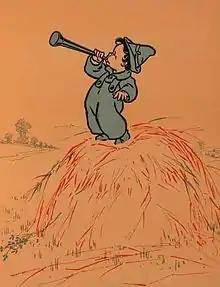| "Little Boy Blue" | |
|---|---|
 1901 illustration by William Wallace Denslow | |
| Nursery rhyme | |
| Published | c. 1744 |
| Songwriter(s) | Traditional |
"Little Boy Blue" is an English-language nursery rhyme. It has a Roud Folk Song Index number of 11318.
Lyrics
A common version of the rhyme is:
Little Boy Blue,
Come blow your horn.
The sheep's in the meadow,
The cow's in the corn.
Where is the boy
Who looks after the sheep?
He's under the haystack,
Fast asleep.
Will you wake him?
No, not I,
For if I do,
He'll sure to cry.
Origins and meaning
The earliest printed version of the rhyme is in Tommy Thumb's Little Song Book (c. 1744), but the rhyme may be much older. It may be alluded to in Shakespeare's King Lear (III, vi)[1] when Edgar, masquerading as Mad Tom, says:
Sleepest or wakest thou, jolly shepheard?
Thy sheepe be in the corne;
And for one blast of thy minikin mouth
Thy sheepe shall take no harme.[2]
It has been argued that Little Boy Blue was intended to represent Cardinal Wolsey, who was the son of an Ipswich butcher, who may have acted as a hayward to his father's livestock, but there is no corroborative evidence to support this assertion.[2] A more plausible, simpler, suggestion, avoiding any reference to Wolsey, is made by George Homans in his book English Villagers of the 13th Century, who writes, after quoting Piers Plowman's description of the hayward and his horn: "The hayward's horn, his badge of office, must have been used to give warning that cattle or other trespassers were in the corn. Little Boy Blue was a hayward." [3]
References
- ↑ "A Short Analysis of the 'Little Boy Blue' Nursery Rhyme". Interesting Literature. 27 November 2018. Retrieved 9 November 2023.
- 1 2 I. Opie and P. Opie, The Oxford Dictionary of Nursery Rhymes (Oxford: Oxford University Press, 1951, 2nd edn., 1997), pp. 98–9.
- ↑ George C Homans, English Villagers of the Thirteenth Century, Harvard University Press, 2nd printing, 1942 p 294